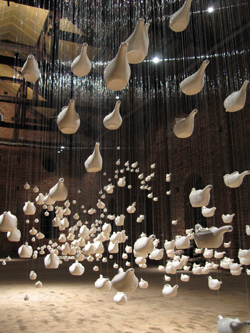
Professor's unique ceramic installation acquired by Museum of Fine Arts, Houston

Its 1,000 porcelain pieces have traveled from Wisconsin to New Haven to Stockholm and back, but this spring professor Denise Pelletier's site-specific ceramic installation, "Vapours," settles into its permanent home at the Museum of Fine Arts, Houston (MFAH). The piece is part of the museum's newly acquired ceramics collection on display now-June 3.
The exhibition, "Shifting Paradigms in Contemporary Ceramics: The Garth Clark and Mark DelVecchio Collection," includes nearly 160 works of modern and contemporary ceramics collected by Clark and Del Vecchio over a period of five decades. The exhibition is accompanied by a stunning 484-page catalogue with essays and detailed entries on 125 featured works, published by Yale University Press.
"This exhibition offers an unparalleled opportunity to see outstanding examples of ceramic art from the post World War II period," said Cindi Strauss, MFAH curator of modern and contemporary decorative arts and design. "The artists represented in the show hail from around the world and are considered the best in the field. Experiencing their creativity through the works is extraordinary."
Pelletier said she's honored to have her work be part of such an important exhibition and part of the permanent collection at the MFAH, one of the largest museums in the country.
"Right now, my piece is there with King Tut," she said.
"Vapours," Pelletier's room-sized installation, has a history of its own. The piece is composed of 1,000 invalid feeders - also known as sick cups - modeled after the 19th and early 20th century versions used in homes and hospitals to feed sick and elderly patients before the use of drinking straws and intravenous feeding equipment. Pelletier created the feeders in 2000 while she was a resident artist at the Kohler Company in Sheboygan, Wisconsin. Using antique feeders as models for molds, Pelletier made successive iterations of the originals, inventing small changes in each new piece and crafting them from the same materials used in the Kohler factory for sanitary ware such as toilets and sinks.
Pelletier's invalid feeders have been used in a series of works that "describe the power and susceptibility of the body through a metaphor of function." The first installation, "For Mary," was inspired by her mother's battle with cancer. It featured exactly 1,000 invalid feeders suspended from the ceiling and lined on the floor at the John Slade Ely House Center for Contemporary Art in New Haven, Conn. A new version of the piece, with the same feeders suspended at all different heights, was installed at Skulpturens Hus in Stockholm, Sweden, in 2005. "Vapours," the current incarnation now on display in Houston, includes 600 of the 1,000 feeders suspended between 10 and 20 feet above ground. (The full installation includes all 1,000 parts, but the exhibition space for this large group exhibition allows only a portion of the whole to be displayed.)
Using the same elements in new contexts to create different works reflects the notion that ceramic objects carry meaning and function through their use, Pelletier said. "The anonymous industrial object becomes personalized through touch, use and sentiment, collecting its value through time and context."
Pelletier, who teaches sculpture and ceramics classes in Connecticut College's art department, said the medium allows her to combine her interests in history, literature, gender studies and anthropology. "Most of my work starts with a historical reference of some kind - sometimes it's an object, sometimes a narrative, sometimes a place," Pelletier said. "I research it, mine elements from it and expand upon it or react to it, intuitively creating a new way to see it. I borrow from literary, medical, industrial and sociopolitical sources, and I love to indulge the imagination by presenting recognizable form as something it is not."
April 16, 2012
